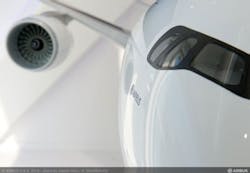Airbus focuses on efficiency, environment throughout A350 XWB life cycle
MONTREAL, 2 Dec. 2013. The A350 was the first program at Airbus to really take efficiency and environmental impact to heart, from design to the supply chain, through manufacturing and aircraft operations, to the end-of-life, explains David Hills, director of research and technology at Airbus S.A.S. in Toulouse, France.
To date, Airbus has received 764 orders from 39 different customers for the Airbus A350 XWB extra-wide-body commercial aircraft. This figure does not take into consideration orders placed during the Dubai Airshow, held last month in the U.A.E.
“The A350 XWB is designed with efficient solutions at every stage of the aircraft life cycle: working with suppliers, in manufacturing to minimize the environmental impact, new approaches and technologies in aircraft, minimizing the environmental impact from operations, and when the aircraft comes to the end of its life,” Hills says.
Hills calls the company’s approach and its A350 XWB “efficiency by design”. The A250 XWB boasts an airframe with advanced materials, state-of-the-art aerodynamics, simple and efficient systems, including robust and efficient power electronics, and the latest-generation engines, he says.
Hills credits simulation and test tools: “More work is being undertaken by simulation to come up with a final optimized solution.”
Manufacturing at the final assembly line in Toulouse, France, benefits from various environmentally friendly innovations: windows and skylights for natural lighting, an efficient energy-management system, and photovoltaic solar panels that produce 55 percent of the building’s energy needs.
“The A350 XWB design favors environment friendly, biodegradable, or recyclable materials,” Hills explains. Airbus is avoiding hazardous substances and using an efficient paint system, applying automotive industry innovations to aerospace.
